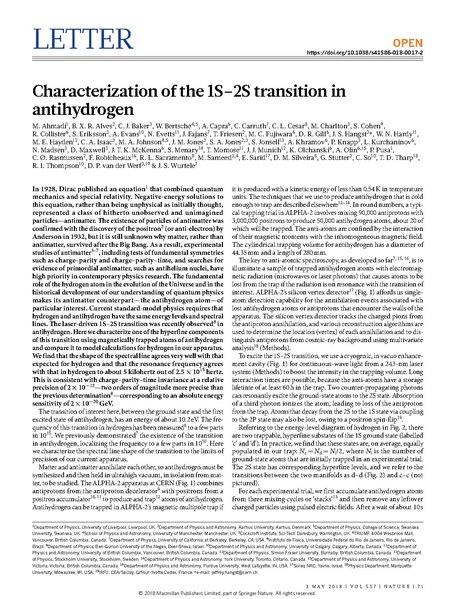File:S41586-018-0017-2.pdf

Size of this JPG preview of this PDF file: 451 × 599 pixels. Other resolutions: 181 × 240 pixels | 361 × 480 pixels | 578 × 768 pixels | 1,239 × 1,645 pixels.
Original file (1,239 × 1,645 pixels, file size: 1.81 MB, MIME type: application/pdf, 9 pages)
File information
Structured data
Captions
Captions
Characterization of the 1S–2S transition in antihydrogen
Summary edit
| DescriptionS41586-018-0017-2.pdf |
English: In 1928, Dirac published an equation1 that combined quantum mechanics and special relativity. Negative-energy solutions to this equation, rather than being unphysical as initially thought, represented a class of hitherto unobserved and unimagined particles—antimatter. The existence of particles of antimatter was confirmed with the discovery of the positron2 (or anti-electron) by Anderson in 1932, but it is still unknown why matter, rather than antimatter, survived after the Big Bang. As a result, experimental studies of antimatter3,4,5,6,7, including tests of fundamental symmetries such as charge–parity and charge–parity–time, and searches for evidence of primordial antimatter, such as antihelium nuclei, have high priority in contemporary physics research. The fundamental role of the hydrogen atom in the evolution of the Universe and in the historical development of our understanding of quantum physics makes its antimatter counterpart—the antihydrogen atom—of particular interest. Current standard-model physics requires that hydrogen and antihydrogen have the same energy levels and spectral lines. The laser-driven 1S–2S transition was recently observed8 in antihydrogen. Here we characterize one of the hyperfine components of this transition using magnetically trapped atoms of antihydrogen and compare it to model calculations for hydrogen in our apparatus. We find that the shape of the spectral line agrees very well with that expected for hydrogen and that the resonance frequency agrees with that in hydrogen to about 5 kilohertz out of 2.5 × 1015 hertz. This is consistent with charge–parity–time invariance at a relative precision of 2 × 10−12—two orders of magnitude more precise than the previous determination8—corresponding to an absolute energy sensitivity of 2 × 10−20 GeV. |
| Date | |
| Source |
https://www.nature.com/articles/s41586-018-0017-2 https://doi.org/10.1038/s41586-018-0017-2 |
| Author | M. Ahmadi et al. |
Licensing edit
This file is licensed under the Creative Commons Attribution 4.0 International license.
- You are free:
- to share – to copy, distribute and transmit the work
- to remix – to adapt the work
- Under the following conditions:
- attribution – You must give appropriate credit, provide a link to the license, and indicate if changes were made. You may do so in any reasonable manner, but not in any way that suggests the licensor endorses you or your use.
File history
Click on a date/time to view the file as it appeared at that time.
| Date/Time | Thumbnail | Dimensions | User | Comment | |
|---|---|---|---|---|---|
| current | 14:43, 21 February 2020 |  | 1,239 × 1,645, 9 pages (1.81 MB) | Pamputt (talk | contribs) | User created page with UploadWizard |
You cannot overwrite this file.
File usage on Commons
There are no pages that use this file.
File usage on other wikis
The following other wikis use this file:
- Usage on www.wikidata.org
Metadata
This file contains additional information such as Exif metadata which may have been added by the digital camera, scanner, or software program used to create or digitize it. If the file has been modified from its original state, some details such as the timestamp may not fully reflect those of the original file. The timestamp is only as accurate as the clock in the camera, and it may be completely wrong.
| Software used | Adobe InDesign CS6 (Windows) |
|---|---|
| Conversion program | Adobe PDF Library 10.0.1 |
| Encrypted | no |
| Page size | 595.276 x 790.866 pts |
| Version of PDF format | 1.4 |
